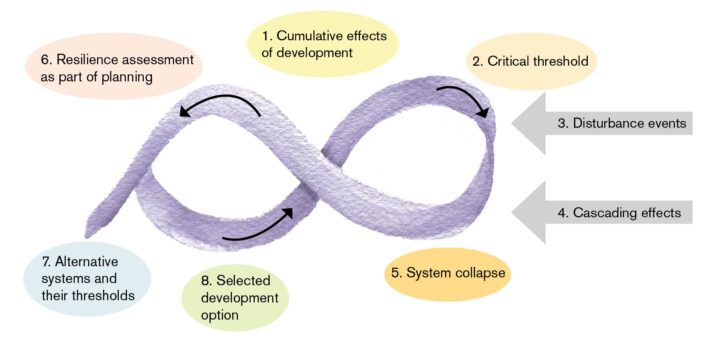The resilience of any complex system is its ability to withstand or recover from disturbance without significant deterioration of its structure and functions. Resilience is a fundamental property of a system and loss of resilience increases the risk of systemic collapse. Any biological system including human societies and economies, the rural landscapes and urban settlements where people live, is a complex system. Biophysical systems that include components such as rocks, soil and water along with living components are also complex systems that change over time in unpredictable ways.
Human activities change systems and can transform them (for example the conversion of forest land to agricultural land) or simplify them, reducing their resilience and increasing the risk that they will collapse and no longer support human wellbeing (for example the degradation of soil through intensive agriculture).
When we use nature, we are intervening in complex systems. As the extent of system modification for human benefit increases, the cumulative effects erode resilience, increasing the risk of systemic collapse. EIA risk assessment typically considers the “probability” of adverse effects and their seriousness, but does not consider the thresholds that mark the boundary between systems that are desirable from a human perspective and those which are not. The climate tipping points that may lead to a “hot house earth” from the cumulative effects of the use of fossil fuel are an example of undesirable thresholds of change.
A resilience assessment can identify the causes of potential failures in the system’s structure or function, and evaluate those changes and propose interventions that would maintain the system in a desirable state. In summary the principles of resilience assessment are, as described in a paper published in 2021 (see reading tips in the end):
- Detailed description of the system and in particular the system’s vulnerability, adaptive capacity, and ability to withstand or recover from disturbance.
- The assessment should include the potential for cascading effects from scales above the system that is the focus of the assessment.
- The objectives of the assessment should be explicit in relation to the time over which the assessment is made, for whom resilience matters and the possible consequences of a development intervention on system change.
- The assessment methodology should cover the dynamic processes within the focal system including the structure and function, mechanisms for change, connections between major parts of the system, and thresholds that can trigger transformation to alternative states.
- Significant assumptions made during the assessment should be clearly stated as planning decisions may be different when based on a different set of assumptions.
- The connections between system components should be described because resilience varies with the number of connections within a system. Too few connections reduce resilience and too many connections make a system vulnerable to external shocks that can be transmitted through the system.
- Evaluation of the potential for significant changes to the system should include consideration of system failure in response to external events as well as failure due to a proposed intervention.
- The consequences of system variables driving a system across a threshold should be defined and the alternative state that could result once the threshold has been exceeded should be described.
- The level of adaptive capacity that exists within a system must be defined as this contributes to the resilience of the system.
Adoption of resilience assessment as part of an EIA means that practitioners and policy makers need to learn about the tools of applied and practice of applied Social-Ecological Systems Science and replace the belief in the certainty of prediction with an acknowledgment of unpredictability and the need to learn how environmental systems change in response to human activity. Learning how systems change in response to human development requires considerable investment in post implementation monitoring, learning and adaptation of policies and practices.
Such an adaptive approach is essential for learning how to cope with the effects of biodiversity loss and climate change and for changing the human activities that currently drive these highly undesirable changes. How do we create change in practice and policy to replace environmental assessment based on prediction and certainty with assessment based on uncertainty and unpredictability to address some of societies greatest challenges?
A previous paper published in 2016 about the barriers to the application of resilience to Strategic Environmental Assessment SEA, which is closely related to and based on the same assumptions as EIA, identified several mental barriers that affect the way we think about the relationship between humans, their activities, and the environment. These barriers can be overcome through education about the new perspectives on environmental change that come from social-ecological systems science and through learning by doing in practice. The resilience principles paper draws the attention of practitioners and policy makers to the differences between conventional impact assessment and resilience assessment.
Read the article in Swedish: Bedömning av resiliens som en del av miljöbedömningen

